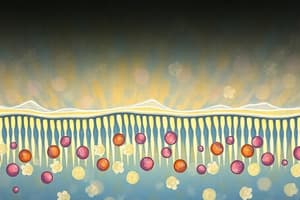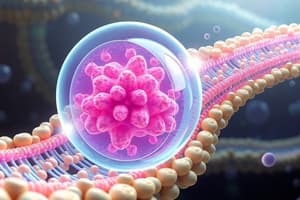Podcast
Questions and Answers
What is a key difference between passive and active transport regarding energy usage?
What is a key difference between passive and active transport regarding energy usage?
- Neither requires energy.
- Only active transport requires energy. (correct)
- Both require energy in the form of ATP.
- Passive transport requires more energy than active transport.
In which direction do passive and active transport move molecules relative to the concentration gradient?
In which direction do passive and active transport move molecules relative to the concentration gradient?
- Both move molecules in the same direction along the gradient.
- Passive transport moves molecules up the gradient, while active transport moves them down.
- Both move molecules up the concentration gradient.
- Passive transport moves molecules down the gradient, while active transport moves them up. (correct)
Which statement best describes the specificity of transport processes?
Which statement best describes the specificity of transport processes?
- Only passive transport uses membrane proteins for specificity.
- Passive transport is more specific than active transport.
- Both types of transport can exhibit specificity based on molecule characteristics. (correct)
- Active transport has no specificity for molecules.
What is a factor that contributes to the transport rate of passive transport compared to active transport?
What is a factor that contributes to the transport rate of passive transport compared to active transport?
What role does the concentration gradient play in both passive and active transport?
What role does the concentration gradient play in both passive and active transport?
What is the primary difference between passive transport and active transport?
What is the primary difference between passive transport and active transport?
What process involves the movement of water through a selectively permeable membrane?
What process involves the movement of water through a selectively permeable membrane?
Which type of transport involves the use of proteins to help molecules cross the cell membrane?
Which type of transport involves the use of proteins to help molecules cross the cell membrane?
Which statement best describes active transport?
Which statement best describes active transport?
What is a key example of primary active transport?
What is a key example of primary active transport?
In secondary active transport, which is required to drive the movement of other molecules?
In secondary active transport, which is required to drive the movement of other molecules?
Which of the following best describes diffusion?
Which of the following best describes diffusion?
What characteristic is shared by both passive and active transport?
What characteristic is shared by both passive and active transport?
Flashcards
Passive Transport
Passive Transport
Movement of molecules across a cell membrane without energy input.
Diffusion
Diffusion
Molecules move from high to low concentration until equilibrium is reached.
Facilitated Diffusion
Facilitated Diffusion
Molecules use proteins to move across the membrane, no energy needed.
Osmosis
Osmosis
Signup and view all the flashcards
Active Transport
Active Transport
Signup and view all the flashcards
Primary Active Transport
Primary Active Transport
Signup and view all the flashcards
Secondary Active Transport
Secondary Active Transport
Signup and view all the flashcards
Concentration Gradient
Concentration Gradient
Signup and view all the flashcards
Transport Specificity
Transport Specificity
Signup and view all the flashcards
Homeostasis
Homeostasis
Signup and view all the flashcards
Study Notes
Passive Transport
- Passive transport is the movement of molecules across a cell membrane without the input of energy from the cell.
- It relies on the natural tendency of molecules to move from an area of high concentration to an area of low concentration, also known as the concentration gradient.
- This type of transport occurs along the concentration gradient. No cellular energy expenditure is required.
- There are several types of passive transport:
- Diffusion: The movement of molecules from an area of higher concentration to an area of lower concentration until equilibrium is reached.
- Facilitated Diffusion: The movement of molecules across a cell membrane with the help of transport proteins, such as channel proteins or carrier proteins. These proteins provide a pathway across the membrane, speeding up the process, but still moving down the concentration gradient requiring no energy.
- Osmosis: The diffusion of water across a selectively permeable membrane from an area of high water concentration to an area of low water concentration. Water moves to equalize the solute concentration on both sides of the membrane.
Active Transport
- Active transport is the movement of molecules across a cell membrane against their concentration gradient.
- This process requires energy from the cell, usually in the form of ATP (adenosine triphosphate).
- It is crucial for maintaining the necessary concentration of certain substances inside and outside the cell that passive transport alone cannot achieve.
- Active transport is essential for essential functions like uptake of nutrients and removal of waste products that often require moving substances against their concentration gradient.
- There are several types of active transport:
- Primary Active Transport: The direct use of ATP for the movement of molecules. Examples involve sodium-potassium pumps that move sodium out of and potassium into the cell.
- Secondary Active Transport: The use of electrochemical gradients created by primary active transport to move other molecules. Such as the movement of glucose into the cell is often coupled with the movement of sodium. Energy is still needed, but it is indirectly using the gradient created by a primary transport action. The movement of sodium down its gradient supplies the energy needed to move glucose up its gradient.
Differences between Passive and Active Transport
- Energy Requirement: Passive transport does not require energy, while active transport requires energy (ATP).
- Movement Direction: Passive transport moves molecules down their concentration gradient, but active transport moves them against it.
- Specificity: Both passive and active transport exhibit varying degrees of specificity to the particular molecules transported. Whether that specificity is dictated by membrane protein shape and charges, or the size of the molecule. In summary, there is a specific transport process for each scenario/molecule. This specificity plays a role in cellular function.
- Transport Rate: Passive transport is often faster than active transport because it doesn't require the cell to expend energy. Active transport involves an enzymatic reaction requiring time. Passive transport simply follows concentration gradient requirements.
- Membrane Protein Involvement: Passive transport often uses membrane proteins like channels or carriers to facilitate the movement of substances across the membrane, whereas active transport uses specific transport proteins for the process to take place against the gradient.
- Concentration Gradient: Both processes use the concentration gradient as a force in some way. Passive transport uses a concentration gradient to drive movement down the gradient while active transport moves substances against the gradient to maintain a desired concentration.
Importance of Passive and Active Transport
- Both types of transport are vital to maintaining homeostasis.
- Active and passive transport are necessary for the cell's continued ability to take in required materials, get rid of waste products, and maintain electrochemical gradients crucial for cellular function.
- This is a necessary function of all living organisms.
Studying That Suits You
Use AI to generate personalized quizzes and flashcards to suit your learning preferences.





